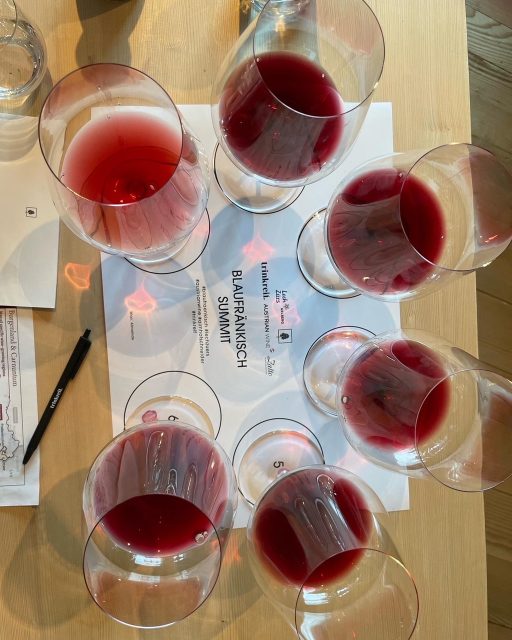This website uses cookies so that we can provide you with the best user experience possible. Cookie information is stored in your browser and performs functions such as recognising you when you return to our website and helping our team to understand which sections of the website you find most interesting and useful.
Is Blaufränkisch a great variety?
An international panel of wine writers and sommeliers joined producers at a Blaufränkisch Summit this week in the Austrian ski resort of Lech to discuss whether this variety deserves to be elevated alongside the likes of Pinot Noir and Nebbiolo as one of the world’s great red wine grapes.

Over a tasting of more than 40 Austrian examples, the group discussed Blaufränkisch’s intrinsic attributes, most notably its high acidity, moderate tannins, mix of dark and red berry fruit, spice and a dried herb component that ties into an overarching freshness.
Although the panel highlighted several stylistic parallels with more internationally famous varieties, Roland Velich, founder of Mittelburgenland producer Moric, stressed the importance of having confidence to define Blaufränkisch on its own terms.
“I was very early onto the market with these wines and was always asked what variety I would compare it to, but here on this Pannonian plain there’s a whole new key which has been forgotten,” he said. Velich noted the challenging political conditions in this part of the world over the last 150 years, which saw the loss of many great Blaufränkisch wines, vineyards and records. “We have to find ourselves, our styles and get experience of our terroir,” he insisted.
Although Austria hosted the summit, there was recognition that its 2,437 hectares of Blaufränkisch vineyard are dwarfed by the almost 8,000ha found over the border in Hungary as Kékfrankos; while Slovenia, Germany and Washington State also have significant plantings under the synonyms Lemberger or Modra Frankinja.
However, there was general consensus among attendees that Austria currently produces the greatest number of consistently high quality examples of Blaufränkisch. In addition, a growing focus among Austrian producers in recent years on single varietal expressions has offered the chance to build a clearer picture of Blaufränkisch’s character.
“Truly we are talking about a rather fast evolution of single variety Blaufränkisch in the last 20 years,” said panel chair Andreas Wickhoff MW as he justified the timing and location of this event.
One factor flagged as key to the quality of Blaufränkisch was its high acidity. “That’s why it has the potential for really age-worthy wines,” noted Wickhoff. Velich noted a shift in attitude among Austrian producers, which has evolved alongside the steady move away from very rich, oaky expressions. “It’s about seeing acidity as a friend with this variety rather than the enemy, which it maybe was in the pursuit of ripeness 20 years ago,” he suggested.
The ability of Blaufränkisch to reflect terroir has also become more apparent as Austrian producers have embraced not just single variety, but single vineyard expressions. Among these is Dorli Muhr in the Carnuntum region. “When I started in Spitzerberg I planted different varieties to see which showed the place,” she explained. “I realised that Blaufränkisch was the grape that expressed Spitzerberg better than all the other varieties.”
For wine writer and long-term Austrian specialist David Schildknecht, “Blaufränkisch has to be serious or not at all.” He drew a contrast with Austria’s more prolifically planted red grape, Zweigelt, which offers producers more generous yields and straightforward vinification to produce cheaper, immediately appealing wine for consumers.
Elaborating on this requirement for bottle age, Muhr observed: “We can’t just put young Blaufränkisch in front of a consumer and say ‘Enjoy’. We really need to hold the wine back a few years.” Velich agreed, noting that he aims to keep back 20-25% of production for later release. “It’s the only way to prove the quality of Blaufränkisch,” he argued; “to allow these wines to develop the charisma that is a factor of great wine.”
Among the obstacles to convincing customers about the greatness of Blaufränkisch, producers expressed frustration at the current requirement for all Austria’s DAC Qualitätswein to gain approval from a tasting panel as representing a typical expression of its region. “We represent our wines in the markets; those four or five people tasting them have no idea,” argued Velich.
Chris Yorke, managing director of the Austrian Wine Marketing Board acknowledged this issue. “It is something we’re looking at,” he confirmed, noting the stylistic discrepancy between domestic wine sales and exports, which account for just 25% of the country’s production.
“There is a palate, a house style, that Austrians like to drink, which is different to international markets,” noted Yorke. “Now we’re starting to see producers who have over half their wine going to international markets, they have a different consumer in mind. The mix of styles of wine we sell in Austria is very different to the mix we sell abroad.”
In particular, Yorke noted the significant amount of wine without a Qualitätswein designation currently being sold abroad, observing: “The average price of non-quality wine is higher than the quality wines. You then ask the question, ‘what is a quality wine?’”
A full report on the Blaufränkisch Summit will appear in a future issue of the drinks business.

